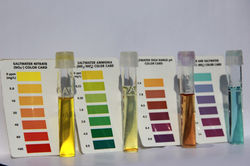Colors, colors, colors! Earths bodies of waters take on many different shapes, forms, and colors.
The Carribean is such a clear blue because it is actually pretty empty - not a lot of nutrients, therefore not a lot of microscopic life like algae and zooplankton. When there are a lot of nutrients in the water, it can actually cause so much life to bloom that the color appears to be brown or even red!
What cheer! Today the journal brought me along the Providence Riverwalk. This beautiful day in the city has got quite a few people out in the river for kayaking and leisurely rides on the gondolas. While it's fun to look up at the skyscrapers around you, have you ever looked down into the river and wondered why its not blue? Or have you ever wondered why the Caribbean has crystal clear water and New England doesn't? Well I have some answers for you!


Providence
 RefractometerThis instrument is called a refractometer, and we use it to measure the amount of salt in the water. Providence River is tidal - but does that mean it's salty? Lets find out. |  Checking salinity levelBy measuring how the light refracts through the water sample, the refractometer can tell us how much salt is in the water. Today, the river is reading 3ppt, or parts per thousand. Fresh water is 0ppt, and open ocean would be 35 ppt. So the river is a little salty, or brackish. |  Adding reagent to test pHWe can test the water to find out its pH (a measure of acidity) as well as see what the levels of nutrients are. |
|---|---|---|
 The reaction is immediateThis is a simple test that you can get at a fish store, and just requires a set amount of water, an special drops that will turn the water different colors depending on what's in the water |  pH purple!This one was a test for pH, and it turned a pretty cool purple color. But what does that mean? |  Determining Chem Levels in ColorBy holding the test tube up against a color chart that comes with the kit, we can read what the levels are |
 The Chem TestsWe test for levels of nitrogen, too - that's an important nutrient for both bacteria and plants - some bacteria like ammonia, and nitrites - which is great because those are toxic to fish. They turn the ammonia and nitrates into nitrate, which is safer for fish, and can be used by algae to grow! |
In some places, the water becomes stratified, meaning that it becomes layered, with fresher, warmer, less dense water on top, and colder, saltier, more dense water on the bottom. Sometimes the denser water contains all the nutrients, and only when the water becomes mixed will life start to bloom again! This usually causes great patches of life in the ocean, such as off west coast of South America, and in the Gulf of Maine.
Not to brag, but water is a beautiful thing! There is so much more to it than you think. Water is defined as a translucent and colorless chemical solution that makes up our Earth's rivers, oceans, lakes, and all organisms that live on this planet are dependent on it for life.
When we see water, though, its seldom JUST water. It can be muddied from runoff from the land or from strong waves mixing up the bottom into the water, and in addition to some of the cool plankton we've seen, it usually contains lots of different chemicals, everything from the salts in salt water to nutrients that help life grow!

Let's find out how to make our own!




Discover
Explore
Dive In
The explorers have made a density jar to show how this mixing can happen! In real life, it's usually where the sea floor becomes elevated, and currents running along the bottom swoop upward with the terrain, bringing all those lovely nutrients that have fallen to the bottom along with them. This is called "upwelling"

